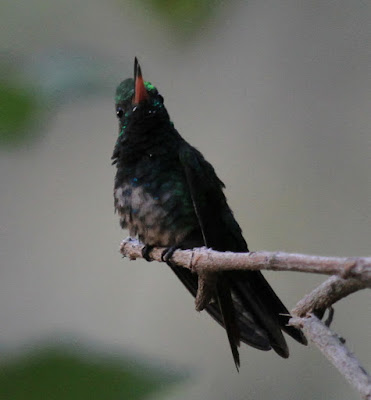Hummingbird identification is a challenge. The birds are tiny and usually don’t sit still long enough to even focus the binoculars, much less get a good look. I learned years go to take a picture first. With modern digital photography and a fast shutter speed, a sequence of photos can often provide enough information for later identification.
Yesterday morning I was standing along a stream under a forest canopy and waiting to see what might fly by. I spotted two hummers by the edge of the stream. They hovered about a foot over some green algae-like growth in the shallowest part of the stream. There were no flowers. Hummingbirds eat insects and I wondered if this hummer ate insects that lived in the aquatic plants. I started to take photos right away. More hummingbirds arrived and I realized this was better than average photo opportunity. I moved to put the sun behind me, which startled the hummers and they disappeared. I stood still and waited, and they returned a few minutes later. Over the course of the next fifteen minutes I took about a hundred photos of the hummers as they descended to bathe in the stream. The hummingbirds usually arrived as a pair but sometimes there were three at a time. They hovered looking down into the water and then they descended into the water and splashed around until their feathers were soaked, and then they flew off. Back at the casa I downloaded the photos and hoped there were enough images in focus to make identify the humminbird. I hit the hummingbird jackpot! The photos allowed a precise identification of four different species! I had presumed I was only looking at one species. A distinctive white band in the tail allowed identification of a Band-tailed Barbthroat. There might well have been more species present. I have not done an internet search about hummingbird bathing behavior to know whether communal bathing is common. Perhaps once a safe location is identified by one species others learn to tag along.
The tail shape and the purple breast and head separated by a green neck allowed identification of a Violet-crowned Woodynmph. The distinctive central green breast stripe allowed identification of a Green-breasted Mango. A great image of a thick coral-red bill with a black tip allowed identification of a Blue-throated Goldentail.


No comments:
Post a Comment